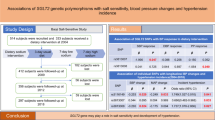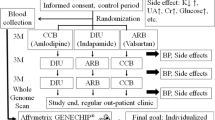Abstract
The majority of single-nucleotide polymorphism (SNP) association studies of salt sensitivity (SS) have focused on SNPs in protein-coding genes rather than on SNPs in noncoding RNAs. This study attempted to identify the association between whole blood microRNA (miRNA)-related SNPs and the risk of SS in a Han Chinese population. A case-control study of 762 individuals was performed. A modified Sullivan’s acute oral saline load and diuresis shrinkage test was used to assess SS. All SNPs were analysed by RT-PCR on a Sequenom Mass ARRAY Platform (Sequenom, San Diego, CA, USA). A genetic risk score (GRS) was used to evaluate the joint genetic effect. In total, 24 miRNA-related SNPs were genotyped, four of which (miR-1307-5p/rs11191676, miR-1307-5p/rs2292807, miR-145/rs41291957 and miR-4638-3p/rs6601178) were associated with both SS and salt sensitivity of blood pressure (SSBP) (p ≤ 0.05). MiR-382-5p/rs4906032 and miR-15b-5/rs10936201 were associated with SSBP. Weighted GRS showed that participants in the second, third and fourth quartiles had 1.760-fold (95% CI: 1.068-2.903), 2.450-fold (95% CI: 1.470-4.083) and 2.774-fold (95% CI: 1.680-4.582) increased risk of SS, respectively. Bioinformatics analysis indicated that these four SNP risk alleles may affect transcription factor binding and influence promoter activity. A total of six miRNA-related SNPs were found to be associated with SS or SSBP, and the presence of multiple risk alleles resulted in increased risk level.
This is a preview of subscription content, access via your institution
Access options
Subscribe to this journal
Receive 12 digital issues and online access to articles
$119.00 per year
only $9.92 per issue
Buy this article
- Purchase on Springer Link
- Instant access to full article PDF
Prices may be subject to local taxes which are calculated during checkout


Similar content being viewed by others
References
Kannel WB, Wilson PW, Nam BH, D’Agostino B, Li J. A likely explanation for the j-curve of blood pressure cardiovascular risk. Am J Cardiol. 2004;94:380–4.
Ha SK. Dietary salt intake and hypertension. Electrolyte Blood Press. 2014;12:7–18.
Elijovich F, Weinberger MH, Anderson CA, Appel LJ, Bursztyn M, Cook NR, et al. Salt sensitivity of blood pressure: a scientific statement from the American Heart Association. Hypertension. 2016;68:e7–e46.
Morimoto A, Uzu T, Fujii T, Nishimura M, Kuroda S, Nakamura S, et al. Sodium sensitivity and cardiovascular events in patients with essential hypertension. Lancet. 1997;350:1734–7.
Gu D, Rice T, Wang S, Yang W, Gu C, Chen CS, et al. Heritability of blood pressure responses to dietary sodium and potassium intake in a Chinese population. Hypertension. 2007;50:116–22.
He J, Gu D, Chen J, Jaquish CE, Rao DC, Hixson JE, et al. Gender difference in blood pressure responses to dietary sodium intervention in the Gensalt Study. J Hypertens. 2009;27:48–54.
Liu Y, Shi M, Dolan J, He J. Sodium sensitivity of blood pressure in Chinese populations. J Hum Hypertens. 2020;34:94–107.
Ha M, Kim VN. Regulation of microrna biogenesis. Nat Rev Mol Cell Biol. 2014;15:509–24.
Liu Y, Usa K, Wang F, Liu P, Geurts AM, Li J, et al. Microrna-214-3p in the kidney contributes to the development of hypertension. J Am Soc Nephrol. 2018;29:2518–28.
Gildea JJ, Carlson JM, Schoeffel CD, Carey RM, Felder RA. Urinary exosome mirnome analysis and its applications to salt sensitivity of blood pressure. Clin Biochem. 2013;46:1131–4.
Moszynska A, Gebert M, Collawn JF, Bartoszewski R. Snps in microrna target sites and their potential role in human disease. Open Biol. 2017;7:170019.
Qi H, Liu Z, Liu B, Cao H, Sun W, Yan Y, et al. Micro-Rna screening and prediction model construction for diagnosis of salt-sensitive essential hypertension. Med (Baltim). 2017;96:e6417.
Qi H, Liu B, Guo C, Liu Z, Cao H, Liu K, et al. Effects of environmental and genetic risk factors for salt sensitivity on blood pressure in Northern China: The Systemic Epidemiology of Salt Sensitivity (Episs) Cohort Study. BMJ open. 2018;8:e023042.
Wain LV, Verwoert GC, O’Reilly PF, Shi G, Johnson T, Johnson AD, et al. Genome-wide association study identifies six new loci influencing pulse pressure and mean arterial pressure. Nat Genet. 2011;3:1005–11.
Liu Z, Qi H, Liu B, Liu K, Wu J, Cao H, et al. Genetic susceptibility to salt-sensitive hypertension in a Han Chinese population: a validation study of candidate genes. Hypertens Res. 2017;40:876–84.
Liu K, Liu Z, Qi H, Liu B, Wu J, Liu Y, et al. Genetic variation in slc8a1 gene involved in blood pressure responses to acute salt loading. Am J Hypertens. 2018;31:415–21.
Mu JJ, Liu ZQ, Yang DY, Xu XL. Erythrocyte sodium-lithium countertransport and urinary kall ikrein excret ion in children with hypertension [in Chinese]. Chin J Hypertension. 1993;2:76–79.
Gong J, Liu C, Liu W, Wu Y, Ma Z, Chen H, et al. An Update of Mirnasnp Database for Better Snp Selection by Gwas Data, Mirna Expression and Online Tools. Database (Oxford). 2015; bav029.
Ward LD, Kellis MH. A resource for exploring chromatin states, conservation, and regulatory motif alterations within sets of genetically linked variants. Nucleic Acids Res. 2012;40:D930–34.
Boyle AP, Hong EL, Hariharan M, Cheng Y, Schaub MA, Kasowski M, et al. Annotation of functional variation in personal genomes using regulomedb. Genome Res. 2012;22:1790–7.
Sandelin A, Alkema W, Engstrom P, Wasserman WW, Lenhard B. Jaspar: an open-access database for eukaryotic transcription factor binding profiles. Nucleic Acids Res. 2004;32:D91–D94.
Lu Y, Quan C, Chen H, Bo X, Zhang C. 3dsnp: a database for linking human noncoding snps to their three-dimensional interacting genes. Nucleic Acids Res. 2017;45:D643–D649.
Yingyao Z, Bin Z, Lars P, Max C, Alireza HK, Olga T, et al. Metascape provides a biologist-oriented resource for the analysis of systems-level datasets. Nat Commun. 2019;10:1523.
Sanghak H, Hua Z, Jin WL, Jeonghee H, Heung CK, Jeong JC, et al. miR-1307-3p stimulates breast cancer development and progression by targeting SMYD4. J Cancer. 2019;10:441–8.
Pavlov TS, Staruschenko A. Involvement of ENaC in the development of salt-sensitive hypertension. Am J Physiol Ren Physiol. 2017;313:F135–F140.
Siguang X, Cui L, Yana M, Hong LJ, Xiumin L. Potential roles of amiloride-sensitive sodium channels in cancer development. BioMed Res Int. 2016;2016:1–6.
Kohlstedt K, Trouvain C, Boettger T, Shi L, Fisslthaler B, Fleming I. Amp-activated protein kinase regulates endothelial cell angiotensin-converting enzyme expression Via P53 and the post-transcriptional regulation of microrna-143/145. Circ Res. 2013;112:1150–8.
Vacante F, Denby L, Sluimer JC, Baker AH. The function of Mir-143, Mir-145 and the Mir-143 host gene in cardiovascular development and disease. Vasc Pharm. 2019;112:24–30.
Rangrez AY, Massy ZA, Metzinger-Le Meuth V, Metzinger L Mir-143 and Mir-145: Molecular keys to switch the phenotype of vascular smooth muscle cells. Circ Cardiovasc Genet. 2011;4:197–205.
Weinberger MH, Fineberg NS, Fineberg SE, Weinberger M. Salt sensitivity, pulse pressure, and death in normal and hypertensive humans. Hypertension. 2001;37:429–32.
Li L, Pan X, Li Z, Bai P, Jin H, Wang T, et al. Association between polymorphisms in the promoter region of Mir-143/145 and risk of colorectal cancer. Hum Immunol. 2013;74:993–7.
Nandakumar P, Tin A, Grove ML, Ma J, Boerwinkle E, Coresh J, et al. Micrornas in the Mir-17 and Mir-15 families are downregulated in chronic kidney disease with hypertension. PLoS One. 2017;12:e0176734.
Zhu LP, Zhou JP, Zhang JX, Wang JY, Wang ZY, Pan M, et al. Mir-15b-5p regulates collateral artery formation by targeting Akt3 (Protein Kinase B-3). Arterioscler Thromb Vasc Biol. 2017;37:957–68.
Saini HK, Griffiths-Jones S, Enright AJ. Genomic analysis of human microrna transcripts. Proc Natl Acad Sci USA. 2007;104:17719–24.
Maen DAZ, Arya M. Wnt signaling, a novel pathway regulating blood pressure? State of the art review. Atherosclerosis 2017;262:171–8.
Jie Z, Jinxiu Z, Jin W, Shan J, Lan X, Larry Q, et al. New mechanism for the sex differences in salt-sensitive hypertension: the role of Macula Densa NOS1β-mediated tubuloglomerular feedback. Hypertension 2020;75:449–57.
Frans HHL, Hong WW, John MH. Sodium pumps, ouabain and aldosterone in the brain: a neuromodulatory pathway underlying salt-sensitive hypertension and heart failure. Cell Calcium. 2020;86:102151.
Jennifer SP, Pamela KC. NOS3 regulation: renal tubular epithelial cells are not simply large endothelial cells. Hypertension. 2006;47:19–21.
Pascal LK, Hung NL, Kelly AV, Alanna CM, Jennifer AN, Eric B. Association of NOS3 Glu298Asp SNP with hypertension and possible effect modification of dietary fat intake in the ARIC study. Hypertens Res. 2010;33:165–9.
Chen K, Rajewsky N. The evolution of gene regulation by transcription factors and micrornas. Nat Rev Genet. 2007;8:93–103.
Luo X, Yang W, Ye DQ, Cui H, Zhang Y, Hirankarn N, et al. A functional variant in microrna-146a promoter modulates its expression and confers disease risk for systemic lupus erythematosus. PLoS Genet. 2011;7:e1002128.
Acknowledgements
The English language usage in this paper was corrected and certified by https://www.aje.cn/services/editing/. The authors are grateful to the patients for participating in this study.
Funding
This research was funded by the National Key Research and Development Program of China (grant number No.2016YFC0900600/2016YFC0900603), the Natural Science Foundation of China (grant number 81973121, 81373076), and the Beijing Natural Science Foundation (grant number 7172023).
Author information
Authors and Affiliations
Corresponding author
Ethics declarations
Conflict of interest
The authors declare no competing interests.
Additional information
Publisher’s note Springer Nature remains neutral with regard to jurisdictional claims in published maps and institutional affiliations.
Supplementary information
Rights and permissions
About this article
Cite this article
Xie, Y., Liu, Z., Liu, K. et al. Polymorphisms of microRNAs are associated with salt sensitivity in a Han Chinese population: the EpiSS study. J Hum Hypertens 36, 171–183 (2022). https://doi.org/10.1038/s41371-021-00485-9
Received:
Revised:
Accepted:
Published:
Issue Date:
DOI: https://doi.org/10.1038/s41371-021-00485-9



